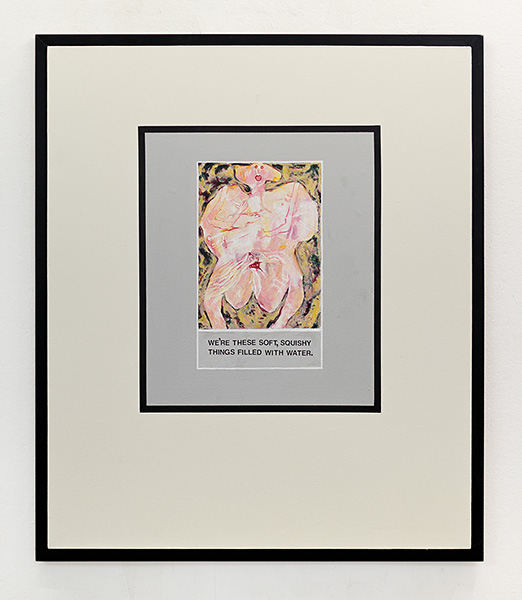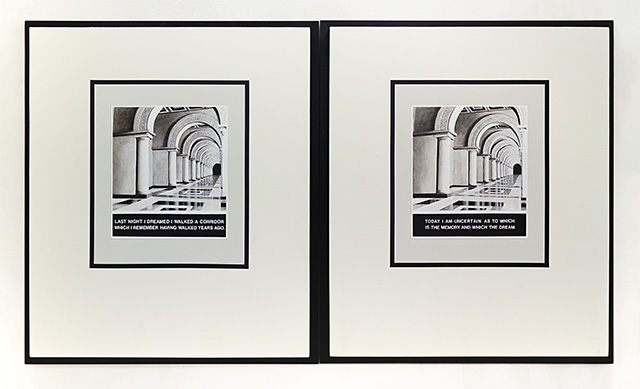Perhaps He Should Have Stayed in the City
Howard Risatti on the Paintings of Bernard Martin
 |
| Bernard Martin, Perhaps He Should Have Stayed in the City ADA Gallery, Richmond Virginia, Sept. 1–Oct. 1, 2017 |
A recent series of paintings by Bernard Martin, all from 2016, leaves little doubt about his attitude toward art. For him it is a serious endeavor that has little to do with art-world trends or the marketplace. It certainly isn’t about making money, something made abundantly clear by With Balloon, a work that features a PR image of Jeff Koons smiling as he holds what looks like one of his characteristic sculptures, a bunny rabbit with a carrot. Why is Koons smiling?
 |
| With Balloon, 2016 Acrylic on canvas 55 1/2 x 47 in. |
By some art-world standards he has been very successful—he was even given a Whitney Museum Retrospective in 2014. But Martin is unimpressed—below the painted image there is text, echoing an old Chinese poem, that lets the viewer know what Martin thinks of this kind of material success: MAKING SHIT FOR THE VERY RICH HAS NOTHING TO DO WITH ART.
Talk about not mincing words. And as if to underscore his belief in art’s seriousness, in With De Kooning, Martin adds the text: THINKING ABOUT DE KOONING: FOR ONE BRIEF MOMENT IT SEEMED POSSIBLE TO BRING TOGETHER ALL THOUGHT AND ALL HISTORY. PERHAPS HE SHOULD HAVE STAYED IN THE CITY. (The city reference concerns de Kooning’s move in 1963 from New York to Long Island.)
These are not offhand remarks, for words play a central role in these works. The text in With Dubuffet, for example, draws the viewer’s attention to the rather grotesque, flattened form of a female figure by referring to her body as composed of SOFT, SQUISHY THINGS. In doing so, Martin draws attention to the classical ideal of female beauty—something that has been a paradigm in visual art since ancient Greece—and, perhaps, also to the idea of the “male gaze.”
 |
| With Dubuffet, 2016 Acrylic on canvas 55 1/2 x 47 in. |
Further issues raised by these works have to do with the sources of their imagery and their picture-within-a-picture format, both of which present the viewer with a visual puzzle that is often heightened by Martin’s text. For instance, as the text in With De Kooning proclaims the seriousness of art, the source of the image Martin has chosen to paint is a black and white photograph taken by Hans Namuth showing de Kooning making a drawing for what would eventually become a painting, his famous Woman I (1950–52). And in With Dubuffet, Martin paints a painting of a painting. In this case the image is from Dubuffet’s L’Arbre de fluides (The Tree of Fluids) from his Corps de dames (Ladies’ Bodies) series, done at the same time as de Kooning’s drawing and sharing with it the same attitude toward the idealized female body.
 |
| With De Kooning, 2016 Acrylic on canvas 57 x 49 in. |
Besides presenting visual puzzles, such works raise theoretical questions because of their format and source material. For instance, does the picture-within-a-picture format undermine the original artist’s work? Moreover, can a painting of someone else’s photograph or painting (e.g., images taken from books or off the internet) still be considered valid, original works of art?
In three additional paintings from the series, Martin raises the ante, so to speak, by the nature of the texts he adds to the images.
 |
| With Magritte, 2016 Acrylic on canvas 55 1/2 x 47 in. |
The source of the image in With Magritte (another painting-within-a-painting) is a self-portrait of surrealist artist René Magritte standing erect with an apple inexplicably floating in front of his face. If this isn’t strange enough, there’s the text. Taken from Hocus Bogus, a 1976 novel by French writer Romain Gary, it states: “I DON’T SPEAK DANISH, BUT NOT WELL ENOUGH.” The text is reminiscent of the Zen koan “the sound of one hand clapping,” and the viewer is left to ponder several questions including how image and text relate, who is “speaking,” what the text means in relation to the image, and, finally, why the reference is to Danish since Magritte was Belgian.
Clearly Martin has been influenced by Magritte’s 1929 painting La trahison des images (The Treachery of Images), a work in which an image of a smoker’s pipe appears above the text Ceci n’est pas une pipe (This is not a pipe): a reminder that objects and their depictions may not necessarily be the same. Like Magritte, Martin’s combinations of text and image also challenge the viewer’s expectations, though at times in a more extreme fashion due to their contradictory nature or their apparent lack of textual logic.
 |
| With Sutra, 2016 Acrylic on canvas 55 1/2 x 47 in. |
Text and image in With Sutra make this latter point in a way that echoes La trahison des images. The image is a simple “line drawing” of a geometric optical illusion called a Necker cube, and it is so visually unstable that without extreme concentration its perspective continually shifts before the viewer’s eyes. One moment it may appear as a three-dimensional cube seen from above, at another as a three-dimensional cube seen from below, and sometimes even as the simple two-dimensional combination of what it actually is: two rhomboids and two squares. The text, THINGS ARE NOT AS THEY APPEAR. NOR ARE THEY OTHERWISE, is a Buddhist sutra (an aphorism or teaching) that at first seems to present a logical conundrum paralleling the unstable visual image. But when we come to realize that, in fact, the sutra is accurate, we are left to question the nature of perception itself.
 |
| With Memory and Dream, 2015 Acrylic on canvas 55 1/2 x 94 in. |
The psychological dimension underlying such works is explored more directly in the diptych With Memory and Dream. It features two paintings of the exact same image placed side by side, but with differing texts. Employing exaggerated perspective in the image, Martin forces the viewer’s eye down a long, colonnaded corridor that ends with an ominous black opening. Is this a portal to the subconscious? Perhaps, because one text questions whether the image is related to a dream, while the other wonders if it is a memory of something that actually occurred. How is one to know for sure?
Like With Memory and Dream, all the works in this series raise questions about what is real and what is not, and what is important and what is not. In doing so, they subtly encourage the viewer to ponder the role played by logic, memory, and preconception in how we come to an understanding of the value of things, especially works of art. ![]()
Photographs courtesy of ADA Gallery and Bernard Martin.
Howard Risatti is a Virginia Commonwealth University emeritus professor of contemporary art, craft, and critical theory; he was the chair of the Department of Craft/Material Studies from 2001–2005. Risatti has written five books that focus on the theory of craft and scholarship of materials.